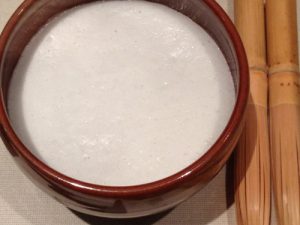
Among Japanese teas, there is a group of teas called furicha (振り茶).
They are made from bancha leaves, and are whisked until froth appears before drinking.
Batabatacha (バタバタ茶) from Toyama prefecture, bukubukucha (ブクブク茶) from Okinawa prefecture, and botebotecha (ボテボテ茶) from Shimane prefecture belong to this group.
Let’s explore batabatacha in this post.
Batabatacha: a Japanese dark tea
It is said that of all the traditional Japanese dark teas, batabatacha is the most similar to Chinese dark teas.
This has to do with its taste, and the way that it’s fermented.
Batabatacha is made in Asahi town of Toyama prefecture, and is sometimes called Asahi kurocha (Asahi dark tea).
The exact history of this tea is unknown, although its process definitely comes from China.
There is written evidence that this tea was being drunk in 1472, but it is probably much older than that.
It used to be part of a Buddhist tradition, where it was drank on death anniversaries, wedding ceremonies, and birth celebrations.
Studies have shown that this tea is particularly rich in vitamin B12.
How batabatacha is processed
Mature leafs from July or August are picked and then boiled until they become yellowish brown.
Then the wet leaves are left on top of a straw mat to dry under the shade for half a day. The fermentation process happens when the leaves are stuffed in a square, two meter wooden box.
Inside the box, the leaves are compressed by a person standing on them.
The temperature is controlled so that it doesn’t go past 60 °C (140 °F). One of the main agents of the fermentation process is the koji mold, and it doesn’t survive past that temperature.
Every four days the tea leaves are loosened. This also evens up the fermentation process, which lasts about a month in total.
Finally, the tea leaves are again dried half a day under the shade, and then for two to three days under the sun.
Brewing batabatacha
Traditionally, this tea is enjoyed many times throughout the day along with light snacks.
It is prepared by boiling about 6 grams of leaves in one liter of water for a long period of time. At least it should be 10 minutes, if not an hour, but it’s not uncommon in Asahi town to boil the leaves for most of the day.
The tea is poured into bowls called gorohachi (五郎八), which are smaller than the usual matcha bowl.
Then a pinch of salt is added, and the tea is whisked.
The tea whisk used is called batabatachasen, and it looks like two long tea whisks joined into one.
I read somewhere that this type of tea whisk is much older than the chasen for matcha, but I haven’t found the source to correctly cite it.
The whisk hits the sides of the tea bowl, making a distinct sound. This is probably where the word batabata comes from.
Once it froths into a white foam, it is ready to drink.
I will review a batabatacha in the next post. It’s a very interesting tea.
Meanwhile, I leave you with a video where you can see batabatacha being whisked.
Sources:
http://www.shokoren-toyama.or.jp/~batabata/index.html

May 31, 2016
I have heard of matcha, bancha and Japanese dark teas but I have never heard of Japanese dark teas that are whisked. Thank you for researching this! I’m really looking forward to your review. Batabatacha seems like a bit of a tongue twister too 🙂
May 31, 2016
Hi Nicole
Thanks for the comment.
Of the three, only batabatacha is a dark tea. And one of them isn’t made entirely of tea.
Hope you like next week’s review 🙂
June 1, 2016
Really interesting Ricardo! – particularly the boiling of the fresh leaf before fermentation and then the boiling for hours of the made tea. I’m guessing that it is a hard tea to find. I would love to read your review and learn about the taste.
June 1, 2016
Hi Linda
While not an easy tea to find, you can still order it online.
It’s getting easier each day to find even the rarest of teas.
June 1, 2016
I have a Japanese tea friend here in Toronto who sells some Japanese teas and goes to Japan every year. I may ask her to either bring some back or see if she knows where I can find it.
See you at WTE!
January 29, 2017
am interested this product where can i get bulk quntity
January 29, 2017
Dear Prabakaran
You can find it in yunomi.life